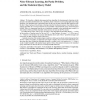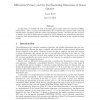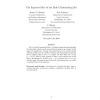587 search results - page 2 / 118 » On the Relative Sizes of Learnable Sets |
STOC
2000
ACM
13 years 11 months ago
2000
ACM
We describe a slightly subexponential time algorithm for learning parity functions in the presence of random classification noise, a problem closely related to several cryptograph...
CIE
2011
Springer
12 years 7 months ago
2011
Springer
Automatic classes are classes of languages for which a finite automaton can decide whether a given element is in a set given by its index. The present work studies the learnabilit...
FOCS
2008
IEEE
14 years 1 months ago
2008
IEEE
Learning problems form an important category of computational tasks that generalizes many of the computations researchers apply to large real-life data sets. We ask: what concept ...
APPROX
2010
Springer
13 years 9 months ago
2010
Springer
In this paper, we consider the task of answering linear queries under the constraint of differential privacy. This is a general and well-studied class of queries that captures oth...
ALGORITHMICA
2006
13 years 7 months ago
2006
Dai, Li, and Wu proposed Rule k, a localized approximation algorithm that attempts to find a small connected dominating set in a graph. In this paper we consider the "average...



